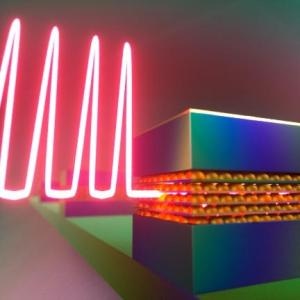Mar 29 2018
Fiber-optic cables, to the tune of thousands of miles, run across the planet and bundle up everything, from cat videos to financial data, into the light. However, upon reaching a local data center, the signal runs into a silicon bottleneck. Rather than light, computers operate on electrons moving through silicon-based chips—which, in spite of vast developments, are less efficient when compared photonics.
 One type of laser that’s particularly suited for quantum dots is a mode-locked laser, which passively generates ultrashort pulses less than one picosecond in duration. (Image credit: Peter Allen)
One type of laser that’s particularly suited for quantum dots is a mode-locked laser, which passively generates ultrashort pulses less than one picosecond in duration. (Image credit: Peter Allen)
To overcome this bottleneck, scientists are making efforts to incorporate photonics into silicon devices. They have been designing lasers, a critical component in photonic circuits, with the ability to function seamlessly on silicon. In a paper to be published this week in the APL Photonics journal, from AIP Publishing, scientists from the University of California, Santa Barbara describe that the future of silicon-based lasers could rely on atom-like, tiny structures known as quantum dots.
Lasers such as these could save a considerable amount of energy. According to Justin Norman, a graduate student at UC Santa Barbara, energy use can be reduced by 20% to 75% percent by substituting the electronic components that connect devices with photonic components. “It’s a substantial cut to global energy consumption just by having a way to integrate lasers and photonic circuits with silicon.”
However, silicon does not have the optimum characteristics to suit lasers. Rather, scientists have alternatively chosen a category of materials from Groups III and V of the periodic table since these materials can be combined with silicon.
Norman stated that at first, they found it difficult to determine a functional integration technique; however, they eventually ended up using quantum dots since they can be directly grown on silicon. Quantum dots are semiconductor particles with a width of just a few nanometers—small enough to function like individual atoms. Upon being driven by using electrical current, positively charged holes and electrons get confined into the dots and recombine to emit light, a property that can be tapped to develop lasers.
The scientists adopted a method called molecular beam epitaxy to develop their III-V quantum-dot lasers. When they deposited the III-V material on the silicon substrate, its atoms self-assembled into a crystalline structure. However, silicon’s crystal structure is different from that of III-V materials, resulting in defects that enable holes and electrons to escape, thereby minimizing the performance. Luckily, since quantum dots are bundled together at higher densities (i.e. over 50 billion dots per square centimeter), they seize the holes and electrons before the loss of the particles.
Norman stated these lasers have various other benefits. For instance, quantum dots are highly stable in photonic circuits since they have atom-like, localized energy states. They can also operate on lesser power as they do not need higher electric current. Furthermore, they can run at higher temperatures and their size can be reduced.
Norman added that within the previous year, scientists have achieved substantial advancements due to developments in material growth. At present, the lasers run at 35 °C without being degraded much, and the scientists note that their service life could be increased up to 10 million hours.
Currently, the researchers are investigating lasers that can run at 60 °C to 80 °C, the more characteristic temperature range of a supercomputer or data center. Norman stated that they are also making efforts to design epitaxial waveguides and other photonic components. “Suddenly,” he stated, “we’ve made so much progress that things are looking a little more near term.”